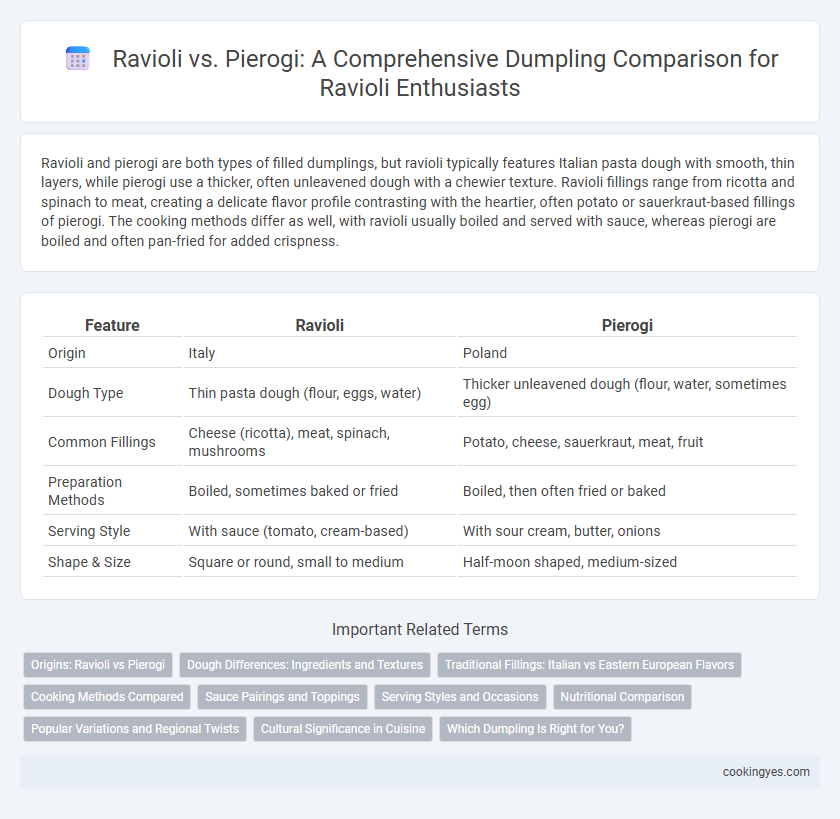Ravioli and pierogi are both types of filled dumplings, but ravioli typically features Italian pasta dough with smooth, thin layers, while pierogi use a thicker, often unleavened dough with a chewier texture. Ravioli fillings range from ricotta and spinach to meat, creating a delicate flavor profile contrasting with the heartier, often potato or sauerkraut-based fillings of pierogi. The cooking methods differ as well, with ravioli usually boiled and served with sauce, whereas pierogi are boiled and often pan-fried for added crispness.
Table of Comparison
| Feature | Ravioli | Pierogi |
|---|---|---|
| Origin | Italy | Poland |
| Dough Type | Thin pasta dough (flour, eggs, water) | Thicker unleavened dough (flour, water, sometimes egg) |
| Common Fillings | Cheese (ricotta), meat, spinach, mushrooms | Potato, cheese, sauerkraut, meat, fruit |
| Preparation Methods | Boiled, sometimes baked or fried | Boiled, then often fried or baked |
| Serving Style | With sauce (tomato, cream-based) | With sour cream, butter, onions |
| Shape & Size | Square or round, small to medium | Half-moon shaped, medium-sized |
Origins: Ravioli vs Pierogi
Ravioli, originating from Italy, traces back to the Middle Ages and reflects Italian culinary traditions with fillings like cheese, spinach, and meat, often served in broth or with sauce. Pierogi, rooted in Eastern European countries such as Poland and Ukraine, have Slavic origins and are typically filled with potato, sauerkraut, or sweet cheese, then boiled or fried. Both dumplings reveal distinct regional ingredients and historical influences, highlighting their unique cultural identities.
Dough Differences: Ingredients and Textures
Ravioli dough typically consists of fine wheat flour, eggs, and water, resulting in a smooth, elastic texture that is tender yet sturdy enough to hold rich fillings. Pierogi dough often uses flour, water, and sometimes sour cream or mashed potatoes, producing a denser, chewier texture with a slightly tangy flavor. These ingredient variations influence how each dumpling cooks and pairs with sauces, with ravioli favoring silky pasta-like qualities and pierogi delivering a heartier bite.
Traditional Fillings: Italian vs Eastern European Flavors
Ravioli traditionally features Italian fillings such as ricotta cheese, spinach, and various herbs, highlighting Mediterranean flavors. Pierogi fillings typically include potatoes, sauerkraut, or ground meat, reflecting Eastern European culinary traditions. Both dumplings offer rich, region-specific taste profiles that showcase their cultural heritage through distinct ingredients.
Cooking Methods Compared
Ravioli cooking typically involves boiling in salted water until they float, ensuring a tender, delicate texture with a thin pasta shell. Pierogi are often boiled first and then pan-fried or baked to achieve a crispy exterior while maintaining a soft, doughy interior. The contrasting methods highlight ravioli's emphasis on a silky finish, whereas pierogi combine boiling and frying for varied textures.
Sauce Pairings and Toppings
Ravioli typically pairs well with rich tomato-based sauces, creamy Alfredo, or sage butter, enhancing its delicate pasta and filling flavors. Pierogi are often topped with sauteed onions, sour cream, and crispy bacon bits, complementing their heartier, potato or cheese-filled dough. Sauce pairings for pierogi tend to be simpler and more rustic, emphasizing savory and tangy flavors that balance their dense texture.
Serving Styles and Occasions
Ravioli are traditionally served in Italian cuisine with various sauces such as marinara, Alfredo, or sage butter, often featured in formal dinners and festive occasions like Christmas. Pierogi, a staple in Eastern European cuisine, are commonly boiled or fried and served topped with sour cream, onions, or bacon, popular in casual family meals and cultural celebrations like Polish festivals. Both dumplings adapt to diverse serving styles, but ravioli lean towards elegant plating, while pierogi emphasize comfort and communal dining.
Nutritional Comparison
Ravioli and pierogi differ significantly in nutritional content, with ravioli typically made from refined wheat flour and filled with cheese, spinach, or meat, providing a balanced mix of carbohydrates, protein, and fats. Pierogi often contain fillings like potatoes, sauerkraut, or cheese, resulting in higher carbohydrate content and a lower protein profile compared to ravioli. Both dumplings vary in calorie density and micronutrients depending on fillings, but ravioli usually offers more iron and calcium due to cheese-based fillings.
Popular Variations and Regional Twists
Ravioli and pierogi showcase diverse popular variations and regional twists that highlight their cultural roots; ravioli often features fillings like ricotta, spinach, and meat across Italian regions, while pierogi are traditionally stuffed with potatoes, cheese, sauerkraut, or meat in Eastern Europe. Southern Italian ravioli may include seafood or truffle-infused fillings, contrasting with Polish pierogi recipes enriched by mushrooms and onions or sweet fruit fillings. The distinct dough textures and serving styles--ravioli typically served with tomato or cream-based sauces and pierogi often boiled and then fried with sour cream--further emphasize their unique regional identities.
Cultural Significance in Cuisine
Ravioli holds a fundamental place in Italian cuisine, often filled with cheese, meat, or vegetables, reflecting regional traditions and festive occasions. Pierogi, central to Eastern European culinary heritage, usually feature fillings like potatoes, sauerkraut, or sweet cheese, symbolizing comfort food and cultural identity during holidays. Both dumplings showcase how food serves as a cultural marker, preserving history and regional flavors in each bite.
Which Dumpling Is Right for You?
Ravioli offers a delicate Italian flavor with fillings like cheese, spinach, or meat, perfect for those craving a tender pasta experience with rich sauces. Pierogi, a staple in Eastern European cuisine, feature dough pockets filled with potatoes, sauerkraut, or sweet fruits, ideal for hearty, savory dishes or sweet treats. Choosing between ravioli and pierogi depends on your preference for Italian elegance or rustic comfort food with diverse savory and sweet options.
Ravioli vs Pierogi for dumpling comparisons Infographic

 cookingyes.com
cookingyes.com